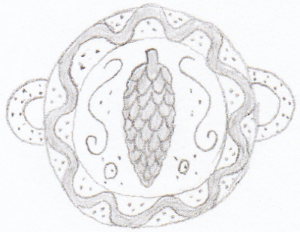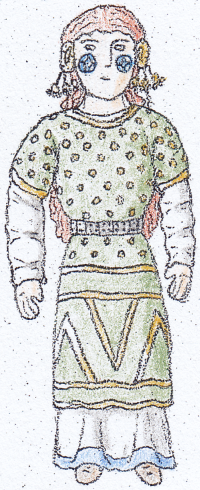Nússans
The nússans1 are the ruling tribe of the kingdom of Nússa in northern Gysikan. Like the Lerdíkans to the southwest, they migrated there during the chaos that followed after the fall of the Paþarían Empire.
Initially invading the region as a part of a confederation, the nússans established their own kingdom centered around the city of Kez Eken (later known as Kessikyl) and gradually absorbed the surrounding tribes via combination of war and diplomacy.
After a brief period of prosperity brought by plundering the ancient city, the nússans are now more concerned with providing caravans with provisions and a place to rest on their way to and from Goldensands to the west, though many wander the neighbouring countries as mercenaries for hire as well.
Most other tribes in Nússa have their own deity resembling Larr and worship them in similar (if not identical) fashion.
Each deity has other trees and altars located throughout Nússa; nússans and lerdíkans alike (especially warriors) sometimes go on a journey to visit each altar before cutting off and sacrificing their hair at Tirtiría's main shrine.
This pilgrimage is believed to ensure victory in battle and, eventually, a pleasant afterlife.
History
The nússans originally lived in the western Wild Mountains in northeastern Adynía, but due to pressure from other tribes they migrated southwards, at first to the shores Tárútan Lake in southern Gráhúlysía, then to Nemirkía before moving eastwards toward Gysikan after hearing stories about the wealthy cities of the Katargysians.Initially invading the region as a part of a confederation, the nússans established their own kingdom centered around the city of Kez Eken (later known as Kessikyl) and gradually absorbed the surrounding tribes via combination of war and diplomacy.
After a brief period of prosperity brought by plundering the ancient city, the nússans are now more concerned with providing caravans with provisions and a place to rest on their way to and from Goldensands to the west, though many wander the neighbouring countries as mercenaries for hire as well.
Culture
Apparel
Nússan clothing, especially women's clothes, combine elements from native gysikani tribes and katargysians with styles brought from northwestern Adynía. Colourful cloaks with geometric patterns are especially favored by warriors.Art
Pottery
Nússans had no tradition of making pottery before migrating from the Wild Mountains, and initially imitated various styles used by the people they had encountered after settling down in Gysikan, but more recently nússans have begun production of white-ground pottery, similar to those developed along the coast to the east.
Their style is notable for combining abstract patterns with images of horses, warriors or certain plants, and for being entirely black-and-white, unlike elsewhere in Gysikan where white-ground pottery is usually painted in bright colours.
Their style is notable for combining abstract patterns with images of horses, warriors or certain plants, and for being entirely black-and-white, unlike elsewhere in Gysikan where white-ground pottery is usually painted in bright colours.
Cuisine
Nússan cuisine mostly consists of bread and porridge made from millet or barley, vegetables, cheese, mutton, goat meat and, to lesser extend, horse meat and beef. Millet beer is common, traditionally sipped through reed straws from a large clay jar.Religion
Major deities
Larr
Patron deity of Nússa, associated with war and rain and often depicted as a horse. Many nússans honour the god by fasting and wrestling (or at watching competitions) during the month dedicated to Larr, at the end of which they sacrifice horses and hold a feast afterwards.Most other tribes in Nússa have their own deity resembling Larr and worship them in similar (if not identical) fashion.
Tirtiría
Goddess of fate, whose main shrine is an altar between three trees on a hill in southeastern Nússa. The trees are said to have been grown from pine cones brought from the Wild Mountains, with one tree representing Tirtiría and the others two closely associated goddesses.Each deity has other trees and altars located throughout Nússa; nússans and lerdíkans alike (especially warriors) sometimes go on a journey to visit each altar before cutting off and sacrificing their hair at Tirtiría's main shrine.
This pilgrimage is believed to ensure victory in battle and, eventually, a pleasant afterlife.
1Original icelandic: Nússar, singular: Nússi





Comments